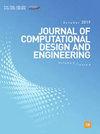Metaheuristic algorithms for a sustainable saffron supply chain network considering government policies and product quality under uncertainty
IF 6.1
2区 工程技术
Q1 COMPUTER SCIENCE, INTERDISCIPLINARY APPLICATIONS
引用次数: 0
Abstract
Iranian saffron products hold a unique position in the global market as the most highly valued agricultural and medicinal commodities. The various uses of saffron make it clear that there is a need for special attention to the supply chain network. Unfortunately, the absence of an integrated supply chain network within the saffron industry has resulted in significant challenges related to supply management and demand fulfillment. Addressing real-world uncertainties is paramount when developing models for optimization problems. Therefore, this research proposes a multi-objective optimization model for designing a saffron supply chain network under uncertainty. The model objectives are to decrease the total cost of the supply chain, increase job opportunities and economic development in regions, and improve the quality of products. The proposed mathematical model is solved using the interactive fuzzy method to deal with multiple functions. Furthermore, possibilistic chance constrained programming is employed to effectively manage uncertain variables such as demand, cost, and social parameters within the model. To demonstrate the applicability and validity of the proposed model and solution method, a real case study was conducted in Khorasan Razavi province, Iran. Additionally, because of the complexity of the proposed model in large-scale networks, NSGA-II and MOSA algorithms are proposed. Different parameters are analyzed to determine their impact on the results so that decision-makers can choose values more accurately. The sensitivity analysis and statistical tests performed on the results support the performance of the proposed model. Overall, the results demonstrate that the exact method and metaheuristic algorithms are capable of solving the problem in different dimensions. The computational results derived from this model offer invaluable managerial insights, empowering decision-makers to align their strategies and preferences more effectively.考虑不确定性下政府政策和产品质量的可持续藏红花供应链网络的元启发式算法
伊朗藏红花产品作为最具价值的农业和医药商品,在全球市场上占有独特地位。藏红花的各种用途清楚地表明,需要特别注意供应链网络。不幸的是,藏红花行业内缺乏一个集成的供应链网络,导致了与供应管理和需求实现相关的重大挑战。在为优化问题开发模型时,解决现实世界的不确定性是至关重要的。因此,本研究提出了不确定条件下藏红花供应链网络设计的多目标优化模型。该模型的目标是降低供应链的总成本,增加区域内的就业机会和经济发展,并提高产品质量。采用交互式模糊方法求解多函数的数学模型。此外,利用可能性机会约束规划有效地管理模型中的需求、成本和社会参数等不确定变量。为了验证所提出的模型和求解方法的适用性和有效性,在伊朗呼罗珊拉扎维省进行了实际案例研究。此外,由于该模型在大规模网络中的复杂性,本文还提出了NSGA-II和MOSA算法。对不同参数进行分析,确定其对结果的影响,以便决策者更准确地选择数值。对结果进行的敏感性分析和统计检验支持所提出模型的性能。总体而言,结果表明,精确方法和元启发式算法能够解决不同维度的问题。该模型的计算结果提供了宝贵的管理见解,使决策者能够更有效地调整他们的战略和偏好。
本文章由计算机程序翻译,如有差异,请以英文原文为准。
求助全文
约1分钟内获得全文
求助全文
来源期刊

Journal of Computational Design and Engineering
Computer Science-Human-Computer Interaction
CiteScore
7.70
自引率
20.40%
发文量
125
期刊介绍:
Journal of Computational Design and Engineering is an international journal that aims to provide academia and industry with a venue for rapid publication of research papers reporting innovative computational methods and applications to achieve a major breakthrough, practical improvements, and bold new research directions within a wide range of design and engineering:
• Theory and its progress in computational advancement for design and engineering
• Development of computational framework to support large scale design and engineering
• Interaction issues among human, designed artifacts, and systems
• Knowledge-intensive technologies for intelligent and sustainable systems
• Emerging technology and convergence of technology fields presented with convincing design examples
• Educational issues for academia, practitioners, and future generation
• Proposal on new research directions as well as survey and retrospectives on mature field.
 求助内容:
求助内容: 应助结果提醒方式:
应助结果提醒方式:


